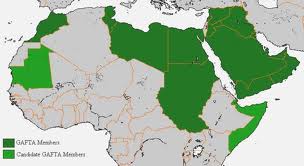Lebanon: GAFTA Council of Arab Economic Unity
2011/06/01
 The Arab League has a long history of trying to foster trade and economic cooperation among its member states, with several initiatives takes in the 1950s and 1960s.
The Arab League has a long history of trying to foster trade and economic cooperation among its member states, with several initiatives takes in the 1950s and 1960s.
In 1981, an agreement to facilitate and promote inter-Arab trade was signed, but to little effect.
In February 1997, the League decided to create an Arab Free Trade Area, also known as the Greater Arab Free Trade Area or the Pan-Arab Free Trade Area, by 2008. This would be achieved through a 10% reduction in customs fees each year as well as the gradual elimination of trade barriers. Eighteen of the 22 Arab League states signed on to this agreement, which came into force on 1 January 1998.
In March 2001, it was decided to speed up the liberalisation process, and on 1 January 2005 the elimination of most tariffs among the GAFTA members was enforced.
The 17 states that are members of GAFTA are: Algeria, Bahrain, Egypt, Iraq, Kuwait, Lebanon, Libya, Morocco, Oman, Palestine, Qatar, Saudi Arabia, Sudan, Syria, Tunisia, United Arab Emirates and Yemen. Others are in the process of joining.
- Related Articles
-
Lebanon’s real estate sector
2011/11/24 Lebanon: Real estate moving along Lebanon’s real estate sector, like the economy in general, is enjoying a surge, with record levels of sales and high returns for investors. However, there are concerns that the property growth could become too much of a good thing, with the rapid increases becoming unsustainable and a correction on the way. -
Lebanon' Debt dynamics
2011/11/24 Lebanon: Debt dynamics Despite the ongoing political stalemate, Lebanon’s economy looks set for continued expansion in 2011, albeit at a somewhat reduced pace, although continued uncertainty may result in higher costs for borrowing when the country seeks to finance its growing budget deficit. -
Lebanon’s retail sector
2011/11/24 Lebanon: Retail sees slowing sales Lebanon’s retail sector could be in for a lean second half of the year, with home-grown political uncertainty, regional instability and a slowing economy all contributing to a less-than-buoyant market atmosphere. -
IMF Data & Forecasts
2011/08/11 2010 2015 Scale Units GDP at constant prices 6621.05 8211.56 Billions
-
- Lebanon News
-
- LEBANON: Dr Alain Hakim, Minister of Economy and Trade
- LEBANON: Lebanon cabinet meets under pressure from trash demos
- LEBANON: Ecotourism attract visitors to Lebanon,Lebanese people to discover their own country
- BAHRAIN: The 6th Ministerial Meeting of the China-Arab Cooperation Forum to be Held in Beijing
- BAHRAIN: Saudi king, most Gulf leaders to skip landmark US summit
- LEBANON: Switzerland to Unfreeze $827 Million in Libyan Assets
- Trending Articles
-
- CASABLANCA: Factories in the sun European firms bring carmaking and an aerospace industry to north Africa
- CHINA: United States sees China investment talks ‘productive’ after new offers
- KENYA: Kenya's tea industry moves toward strategic diversification
- CHINA: Djibouti partners with China to develop local infrastructure and global trade routes
- BOTSWANA: Routes Africa forum aims to improve African air connectivity
- CHINA: Morocco and China sign $1.54bn currency swap agreement








